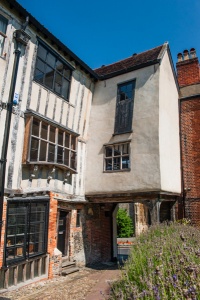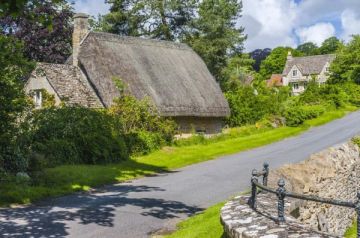
House, Tombland
Tombland is the very heart of Norwich, the centre of activity here before the Norman's arrived in England in 1066. In this area was the palace of the Earl of East Anglia, and St Michael's church, the largest in Norwich.
You might be forgiven for imagining that the name 'Tombland' comes from some long past use as a burial ground. Nothing could be further from the truth; the name comes from two Old English words meaning 'open ground', or empty space. This open ground was used as the main market place for Norwich; the hub of commercial activity and town life.
At least it was before the Normans arrived and built an imposing castle on a high mound to the south. The Normans moved the main market area to an open space at the foot of the castle mound, at least partly so they could keep a close eye on what passed. They also transformed Tombland; Bishop Henry de Losinga pulled down the earl's palace and St Michael's church and built a grand new Norwich Cathedral closer to the River Wensum.

1272 Riots
But Tombland continued to be used for fairs, including an annual horse fair. And it was one of these fairs that led to an outbreak of violence in 1272. To give the events a bit of background, there had been an ongoing squabble between the monks of the cathedral priory and the townsfolk of Norwich over land rights.
The sequence of events seems confusing. The citizens claimed that one of their numbers had been killed by a monk. They wanted the monk brought to justice through the king's courts. The monks refused, saying that the secular justice system had no power over clerics.
Violence flared, and the townsfolk fired burning arrows from the tower of St George Tombland church, over the walls that protected the cathedral close. The cathedral bell tower was burned, priory buildings damaged, and the church of St Ethelred inside the walls was destroyed.
The prior fled to Great Yarmouth and gathered a band of armed men, and these hirelings roamed the streets of Tombland and Elm Hill, exacerbating the violence. Edward III was forced to step in, and when he did, he sided with the monks. The citizens of Norwich were fined, and over 30 leaders of the town executed.
The king made Norwich agree to build a new gateway to the cathedral close, incorporating a chapel to replace the destroyed church of St Ethelred. The result is Ethelred Gate, built around 1320, with a small chapel over the gateway arch.

A second gate to the cathedral from Tombland was erected around 1420 by Sir Thomas Erpingham, leader of the English archers at the Battle of Agincourt. The Erpingham Gate is decorated with figures of saints on the gateway mouldings, and a kneeling figure of Erpingham himself appears over the arch.
Edith Cavell Memorial
Beside the Erpingham Gate is a monument to Edith Cavell, who was born just outside the city of Norwich. Cavell is famous for her role in helping Allied servicemen to escape from occupied Belgium during WWI. She was eventually discovered and shot, but later brought to Norwich Cathedral for burial.
Her grave lies on the south side of the cathedral exterior, but this large memorial was erected to her memory in Tombland. Just behind the statue is the oldest part of the cathedral precinct wall, dating to the 12th century.
Augustine Steward House
Facing the Cavell memorial across Tombland is the Tudor house of Augustine Steward, a wealthy cloth merchant and 3 time Mayor of Norwich. Steward was born in the house in the late 15th century, moved away, but later repurchased the property and rebuilt it to the state we see today, with a projecting upper storey and lovely timber-framing.

Samson and Hercules
Next door is Samson and Hercules House, so named for two statues that flank the doorway. The house was built in 1656 by Christopher Jay to celebrate his appointment as Mayor, but it incorporates a much earlier 15th-century mansion built by Sir John Fastolf (1380-1459).
Fastolf was a successful soldier under Henry V, but in 1429 he lost a battle at Patay to Joan of Arc and gained an undeserved reputation for cowardice. He later became the inspiration for Shakespeare's Falstaff character. After Fastolf's death, his mansion in Tombland was owned in turn by the Duchess of Suffolk and the Countess of Lincoln.
After Christopher Jay's death, the house passed through numerous hands, being used for offices, a residence, a surgeon's practice, and a wool-combing business. In the 1920s it became a YWCA, ballroom, and a dance hall. The statues which give the house its name were installed by Jay when the house was built. They were made of wood, covered in paint and enamel.
By 1999 the original statues required restoration, so replicas were installed in their place. Samson and Hercules House is said to be haunted by the ghosts of three monks who died in a plague in 1578. They were among upwards of 5000 victims of the plague, many of whom were buried in mass graves beneath Tombland.

A stone's throw from Augustine Steward's house, at the entrance to Princes Street, is the church of St George Tombland. It was from the tower of this church that the citizens of Norwich shot burning arrows into the cathedral close in 1272. The tower was rebuilt in the 15th century.
The church itself contains some excellent historic memorials, including one to Thomas Anguish, a Sheriff and Mayor of Norwich, who lived at the corner of Wensum Street and Tombland, where the Maid's Head Hotel now stands.
In 1611 a great celebration was held when Anguish was appointed mayor. The celebration was meant to include a fireworks display, but the fireworks went off into the crowd, causing a panicked stampede, and over 30 people were killed. From that point on, fireworks were banned from use on feast days.

The Maid's Head Hotel
The Maid's Head is thought to be the oldest hostelry in England, with a history of hospitality dating back over 8 centuries. It was built to house important visitors to the nearby cathedral, and over the years it has sheltered such famous names as Elizabeth I, The Black Prince, and Catherine of Aragon.
Kett's Rebellion
Violence seems to have been a recurring theme in the history of Tombland. In 1549 Robert Kett led a rebellion against the enclosure of common land. After a fierce attack on Bishop Bridge, Kett and his band of followers gained access to the city and took the Mayor, Thomas Codd, prisoner.
They ransacked Augustine Steward's House but did not harm Steward himself. Later, the Earl of Warwick led government troops into Norwich, and the Earl made his headquarters in Steward's house in Tombland.
Violence broke out again in 1766, during a time of grain shortage due to poor harvests. Crowds accused local businesses of profiteering and attacked local mills, as well as a bakery in Tombland. The Mayor read the Riot Act to call out local citizens, who armed themselves with clubs and drove the mob away.
Today Tombland is peaceful, a cobbled area lined with cafes and shops on one side and the cathedral precinct on the other. To the west lies Elm Hill, to the north the River Wensum. It is calm and serene, but no matter where you look, there is history.


